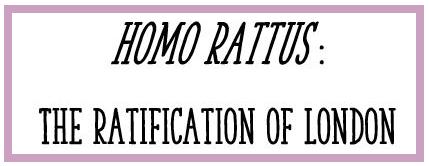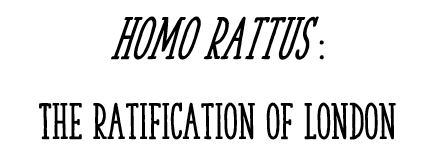The following has been observed first-hand on the London Underground. I don't know about other cities, but I imagine there are similar phenomena on the Paris Metro and the New York Subway. It being 2020 - the Year of the Rat - means that it is fitting to mention this now. When commuters spend their mornings and evenings in a subterranean railway world, squeezed down escalators and crushed into sewer tunnels, like rats into a hole, one after the other, rattification is inevitable. Unnoticed, even, because of its inevitability. When everyone else is as rattified as you are, you cease to notice the changes, which in themselves, appear slowly. And it is not a sudden thing. Rattification happens gradually and deliberately and it is easily overlooked.
First signs of rattification are a certain glimmer in the eyes, often described as beadiness. You begin to see things you didn't before: the exact type of grime in the grout of the station tiles; the precise contours of muddy footprints on the station floor. It's ultraviolet, multi-dimensional, glow-in-the-dark vision, and it's pretty cool. Next are some olfactory changes: beyond tube dust and track grease you can now smell eau de parfum worn by someone three stations away. Then, as your ears become sharper, you hear cars rumbling along streets far above you, and if you really listen, snippets of above-ground conversations. Steps four and five are not physical changes, but a shift in demeanour, and a kind of fearlessness that wasn't there before. Some dietary changes also follow: a penchant for cheddar cheese and raisins and peanut butter. Finally, with the sprouting of thin whiskers either side of the nose, rattification is largely done.
It is important to note that rattification is not a good thing or a bad thing. It is just a thing. The next evolutionary step, maybe. Humans are supposed to adapt and here we see humans adapting, naturally, to their rat-lives. The new breed of humans who have fully adapted, the homo rattus, are visible in any tube station on any weekday morning. One question that follows, which I am asked often, is whether rattification is reversible. Is it a one-way process, with its subjects bound to rat-life forever? Or can rattification be "un-done"? Upon crawling out of tube stations and arriving at their workplaces, rattified Londoners return to their normal state. Rattification is, at least at the time of writing, reversible. But I ask this: should it be? The evolutionary process is not to be feared. There is nothing inherently troubling about it. Of course, there are some side effects to it: the homo rattus sometimes carries the plague, and recent attempts to curb this have caused a brief intermission in the city's rampant rattification.
Interestingly, there are some people who suggest that rattification should be celebrated. "Go out", they say, "and embrace your rattified lives!". People travelling to work every morning sometimes report feeling that one day blends into the next, without real distinction. But they are unaware that each day is marvellously, significantly, different to the next. With each day, with each commute, with each minute spent underground, they are changing, violently - they are rattifying themselves, right here in Rat City.




